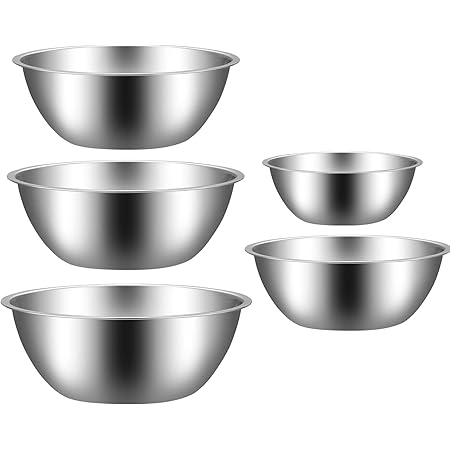Stainless steel bowls have become a kitchen essential for many, prized for their durability, sleek appearance, and seemingly inert nature. But are these shiny receptacles truly safe for storing your precious food? The short answer is a resounding yes, but let’s delve deeper into the reasons why, addressing common concerns and highlighting the advantages of using stainless steel for food storage.
Understanding the Composition: Why Stainless Steel Shines

Stainless steel is an alloy, meaning it’s a combination of different metals, primarily iron, chromium, and nickel. This combination is what gives stainless steel its remarkable properties. The chromium content is crucial, as it creates a passive layer of chromium oxide on the surface. This layer acts as a protective barrier, preventing rust and corrosion, and making the steel incredibly resistant to stains and odors.
This protective layer is key to food safety. Unlike some other materials that can leach chemicals into food, the chromium oxide layer on stainless steel remains largely inert, meaning it doesn’t react with or break down into food. This makes stainless steel a remarkably safe choice for storing a wide variety of foods, from leftovers to delicate sauces.
Debunking Myths: Addressing Common Concerns

While stainless steel’s safety is well-established, some concerns linger. Let’s tackle them head-on:
Myth 1: Stainless Steel Reacts with Food
This is largely untrue. While highly acidic or alkaline foods might cause minor discoloration on the bowl’s surface (a purely aesthetic issue), the steel itself won’t leach harmful chemicals into your food. This discoloration can often be easily removed with a gentle scrub.
Myth 2: Nickel Leaching is a Major Risk
Nickel allergies are a legitimate concern for some individuals. However, the amount of nickel that might leach from a properly manufactured stainless steel bowl is typically extremely minimal and unlikely to trigger a reaction in most people. High-quality stainless steel bowls use food-grade steel, rigorously tested to minimize nickel leaching. If you have a severe nickel allergy, it’s always wise to err on the side of caution and opt for alternatives.
Myth 3: Stainless Steel Bowls Are Not Microwave Safe
Most stainless steel bowls are indeed microwave safe, but it’s crucial to check the manufacturer’s instructions. Some bowls may contain non-stainless steel components that aren’t suitable for microwaving. Look for clear labeling indicating microwave suitability before heating food in your stainless steel bowl.
The Advantages of Choosing Stainless Steel

Beyond its safety, stainless steel bowls offer several compelling advantages:
- Durability: Stainless steel is incredibly strong and resistant to damage, making these bowls a long-term investment for your kitchen.
- Easy Cleaning: Stainless steel is non-porous, meaning bacteria and odors don’t readily cling to the surface. They are usually dishwasher safe, making cleanup a breeze.
- Versatility: Stainless steel bowls can withstand high and low temperatures, making them suitable for both freezing and refrigerating food.
- Aesthetic Appeal: Their sleek, modern design enhances the look of any kitchen.
- Sustainability: Stainless steel is highly recyclable, making it an environmentally friendly choice.
Choosing the Right Stainless Steel Bowl: A Buyer’s Guide
Not all stainless steel bowls are created equal. When selecting bowls for food storage, consider these factors:
- Gauge: A higher gauge (lower number) indicates thicker, more durable steel.
- Grade of Steel: Look for food-grade 18/8 or 18/10 stainless steel, which indicates a higher chromium and nickel content, enhancing durability and safety.
- Construction: Seamless bowls are generally preferable to avoid potential crevices where bacteria might accumulate.
- Manufacturer Reputation: Opt for reputable brands known for their quality and commitment to food safety.
Conclusion: A Safe and Sensible Choice

In conclusion, high-quality stainless steel bowls are a safe and practical choice for storing food. Their durability, ease of cleaning, and inert nature make them an excellent addition to any kitchen. By understanding the composition of stainless steel and choosing reputable brands, you can confidently utilize these versatile bowls for all your food storage needs, contributing to a healthier and more organized kitchen environment.